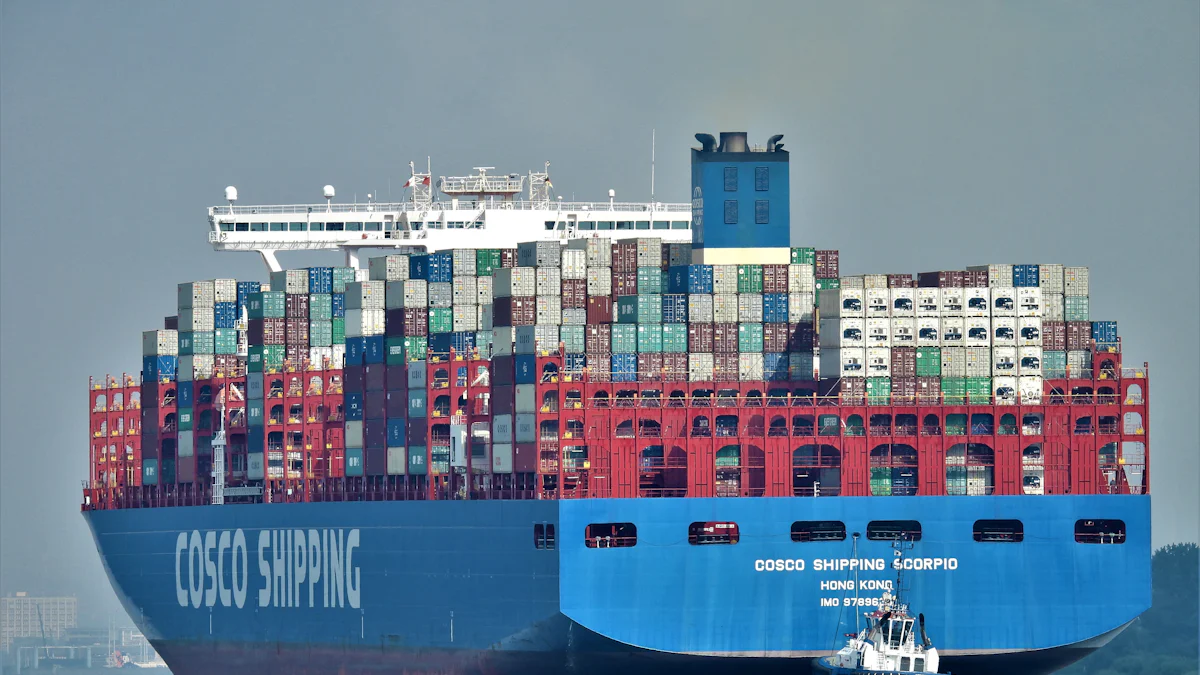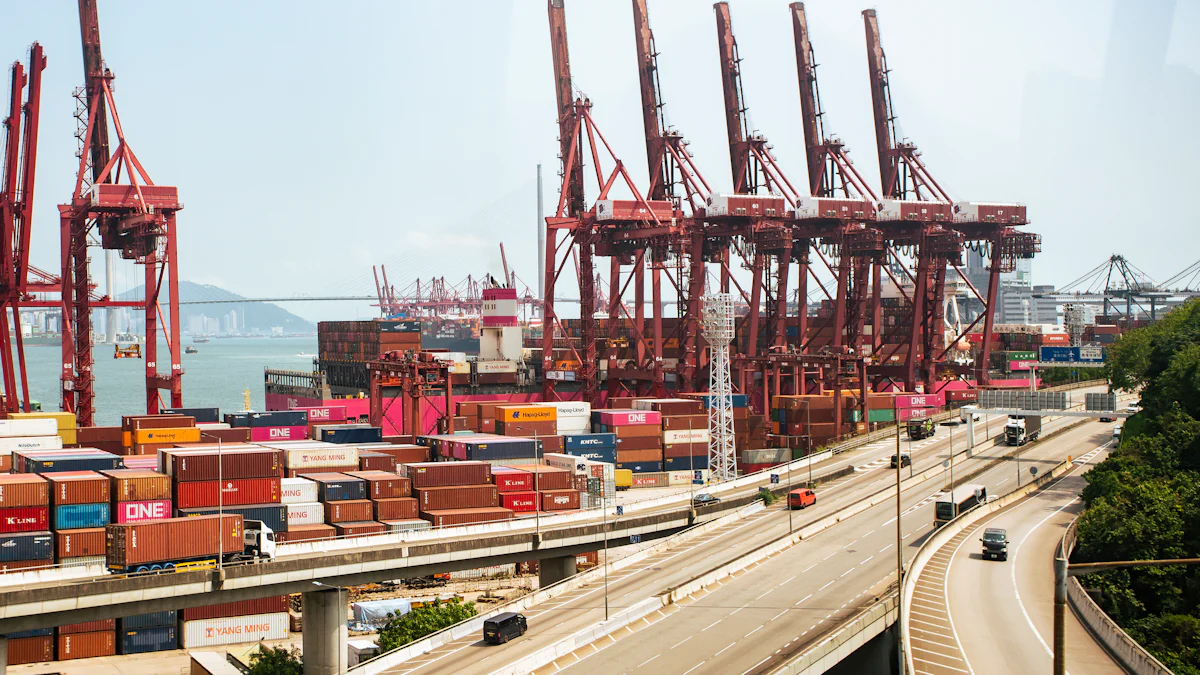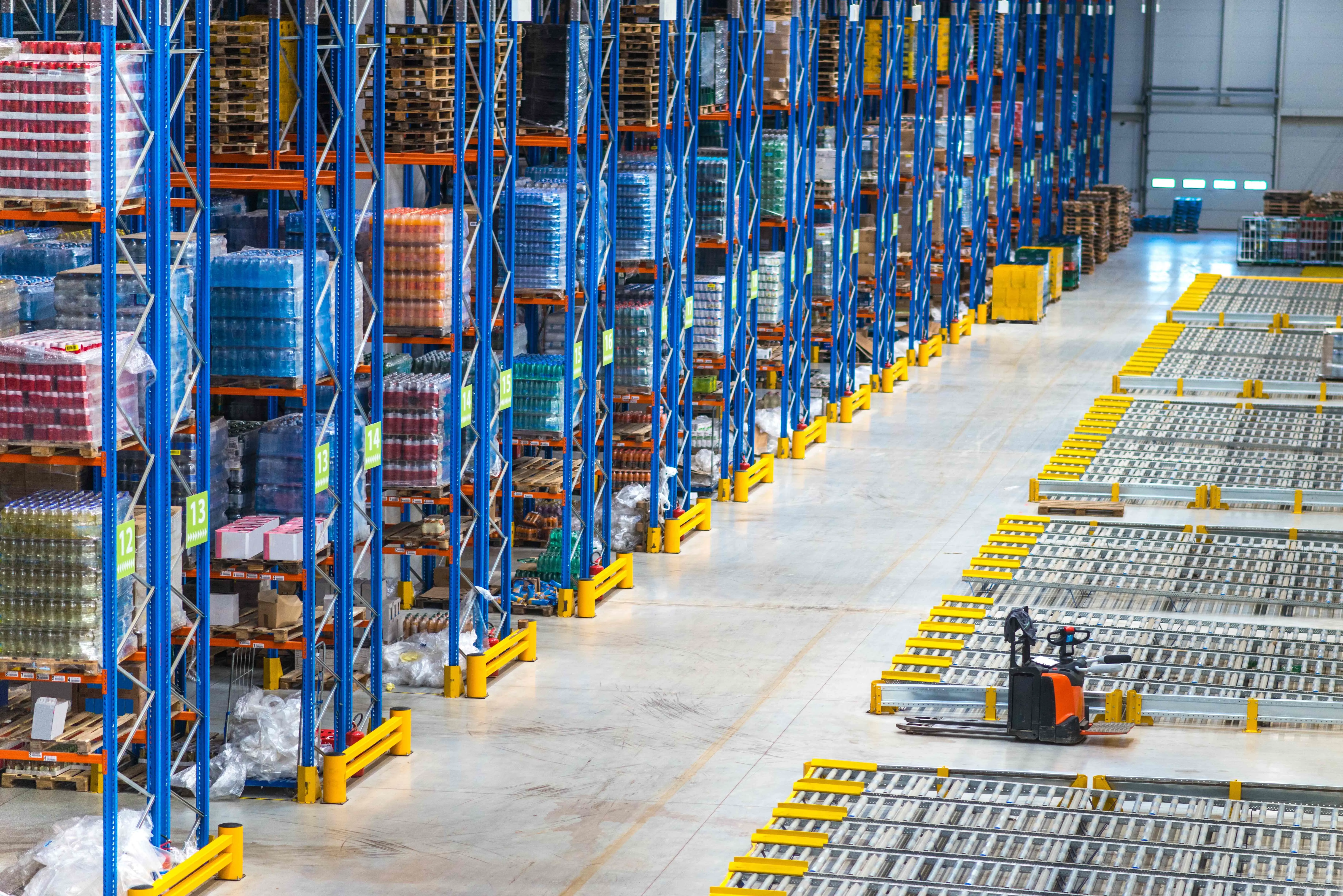ocean freight rate forecast 2025

The ocean freight industry faces a dynamic landscape in 2025, shaped by evolving trade policies, geopolitical shifts, and fluctuating global demand. Container volumes are projected to grow by 3-4%, reflecting robust shipping activity. However, freight rates may remain high due to capacity expansions outpacing demand growth. Businesses must prioritize freight rate analysis to navigate these complexities effectively. Understanding these trends enables companies to manage costs, adapt to market changes, and maintain profitability in an increasingly competitive global supply chain.
Key Takeaways
Freight rates in 2025 may stabilize in some areas but could remain volatile in others due to capacity expansions outpacing demand growth.
Businesses should prioritize freight rate analysis to effectively manage costs and adapt to market changes in the competitive global supply chain.
Investing in digital technologies like IoT and predictive analytics can enhance visibility and efficiency, helping companies respond quickly to disruptions.
Diversifying shipping routes and carriers can mitigate risks associated with geopolitical tensions and supply chain disruptions.
Long-term contracts with carriers can provide stability and predictability in an unpredictable market, protecting against sudden price hikes.
Adopting green shipping technologies not only complies with regulations but also reduces operational costs, positioning companies as leaders in sustainability.
Utilizing JUSDA's JusLink platform can empower businesses with real-time insights, enabling them to optimize logistics strategies and adapt to changing market conditions.
Current Market Conditions and Trends Leading to 2025

Overview of 2023-2024 Freight Market Trends
Post-pandemic recovery and its impact on ocean freight
The post-pandemic period has brought significant changes to the ocean freight industry. After the initial disruptions caused by COVID-19, the market began stabilizing in 2023. However, freight rates remained volatile due to lingering supply chain bottlenecks and uneven recovery across regions. Port delays, labor shortages, and container imbalances continued to challenge the industry.
"Spot rates peaked in 2021, exceeding the average cost per mile by over $1. By 2023, spot rate compression and rising costs reduced this margin to nearly zero."
This trend highlights the fluctuating nature of the shipping market. As global trade volumes gradually recovered, businesses faced higher transportation costs, making freight rate analysis a critical tool for managing expenses.
Fluctuations in global trade volumes and economic growth
Global trade volumes experienced uneven growth during 2023-2024. Economic forecasts indicated that pent-up demand across key sectors, coupled with easing Federal Reserve rate policies, could drive moderate recovery. Container transport volumes are projected to grow by 3-4% annually, reflecting increased activity in the ocean freight market. However, this growth remains tempered by geopolitical tensions and inflationary pressures.
The shipping market also saw shifts in trade patterns. Emerging markets in Southeast Asia gained prominence as manufacturing hubs, while traditional trade routes faced disruptions. These fluctuations underscored the importance of adapting to changing trade dynamics to maintain competitiveness.
Key Challenges Facing the Ocean Freight Industry
Port congestion and infrastructure limitations
Port congestion emerged as a persistent challenge for the ocean freight industry. Major ports worldwide struggled to handle increased cargo volumes, leading to delays and inefficiencies. Infrastructure limitations, such as outdated equipment and insufficient capacity, exacerbated the problem.
"Recent spikes in freight rates have drawn significant attention, with delays at ports contributing to rising costs."
Efforts to modernize port facilities and streamline operations became essential to address these bottlenecks. Investments in automation and digital technologies offered potential solutions to improve efficiency and reduce congestion.
Rising fuel costs and environmental regulations
Rising fuel costs placed additional pressure on freight rates. The adoption of stricter environmental regulations, such as the International Maritime Organization's (IMO) 2023 carbon intensity targets, further increased operational expenses for shipping companies. These regulations aimed to reduce greenhouse gas emissions but required significant investments in cleaner technologies and alternative fuels.
Shipping companies faced the dual challenge of complying with environmental standards while managing costs. The push for sustainability reshaped the ocean freight market, driving innovation and collaboration across the industry.
Emerging Opportunities in the Freight Market
Growth in e-commerce and its impact on freight rates
The rapid growth of e-commerce created new opportunities for the ocean freight industry. Increased demand for fast and reliable shipping services drove innovation in logistics and supply chain management. Businesses sought to optimize their operations to meet consumer expectations for timely deliveries.
E-commerce also influenced freight rates by increasing demand for smaller shipments and flexible shipping options. Companies that adapted to these trends gained a competitive edge in the evolving market.
Adoption of digital technologies in freight management
Digital transformation played a pivotal role in reshaping the ocean freight market. Technologies such as IoT, blockchain, and AI enhanced visibility and efficiency across supply chains. Real-time tracking, predictive analytics, and automated processes enabled businesses to make informed decisions and respond quickly to disruptions.
"Economic forecasts suggest that growth will impact freight demand, creating opportunities for expanding operations and capturing new markets."
The integration of digital tools allowed companies to streamline operations, reduce costs, and improve customer satisfaction. As the industry embraced innovation, digital technologies became a cornerstone of modern freight management.
Technological Advancements and Sustainability
Adoption of green shipping technologies
Environmental sustainability remains a priority for the ocean freight industry. Stricter regulations, such as the IMO's carbon intensity targets, have accelerated the adoption of green shipping technologies. Investments in cleaner fuels, energy-efficient vessels, and emission-reduction technologies aim to minimize the environmental impact of shipping operations.
These advancements not only address regulatory requirements but also enhance operational efficiency. Companies adopting sustainable practices can reduce fuel consumption and operational costs, positioning themselves as leaders in an increasingly eco-conscious market.
Automation and digitalization in logistics
Technological innovation continues to transform the ocean freight industry. Automation and digitalization enhance efficiency across supply chains, enabling real-time tracking, predictive analytics, and streamlined operations. Tools like IoT and AI provide valuable insights, helping companies optimize routes, reduce delays, and improve decision-making.
Digital platforms also facilitate better collaboration among stakeholders, ensuring transparency and accountability. As the industry embraces these technologies, companies that prioritize innovation will gain a competitive edge in the evolving market.
The Role of JUSDA in Addressing Freight Challenges
Leveraging JusLink Intelligent Supply Chain for real-time freight rate analysis
JUSDA's JusLink Intelligent Supply Chain platform provides businesses with a cutting-edge solution for navigating the complexities of ocean freight rates. By integrating IoT, cloud computing, and big data, JusLink enables real-time freight rate analysis, offering unparalleled visibility into market trends and pricing fluctuations. This capability empowers companies to make informed decisions, optimize shipping strategies, and mitigate risks associated with volatile freight markets.
"Supply and demand dynamics in ocean shipping remain complex, with evolving trends and unpredictable fluctuations shaping the market."
JusLink addresses these challenges by delivering actionable insights through predictive analytics. Businesses can anticipate rate changes, identify cost-saving opportunities, and adapt to shifting market conditions. The platform's ability to process vast amounts of data ensures accuracy and reliability, making it an indispensable tool for supply chain managers.
Additionally, JusLink enhances collaboration across the supply chain. Its real-time tracking and reporting features foster transparency, enabling stakeholders to coordinate effectively. This level of integration reduces inefficiencies, minimizes delays, and ensures that businesses remain competitive in a rapidly changing global trade environment.
Enhancing supply chain efficiency with JUSDA’s global logistics solutions
JUSDA's global logistics solutions play a pivotal role in addressing freight challenges by streamlining supply chain operations. With over 155 service points worldwide and a warehouse area exceeding 2,500,000 square meters, JUSDA offers a robust infrastructure to support businesses across industries. These resources enable seamless coordination of air, land, sea, and rail transportation, ensuring timely and cost-effective delivery of goods.
The company's focus on technological advancements further enhances operational efficiency. Automation and digitalization, key drivers of modern logistics, are integral to JUSDA's approach. Tools such as AI-powered demand forecasting and dynamic inventory management optimize resource allocation, reduce waste, and improve overall performance.
"Technological advancements present significant growth opportunities in the shipping industry, enhancing operational efficiency and reducing costs."
JUSDA's commitment to sustainability also sets it apart. By adopting green shipping technologies and promoting eco-friendly practices, the company aligns with global efforts to reduce the environmental impact of logistics. This approach not only complies with regulatory standards but also positions JUSDA as a leader in sustainable supply chain management.
Furthermore, JUSDA's China-Europe Express Rail service complements its ocean freight offerings by providing a faster and more cost-effective alternative for intercontinental trade. This multimodal approach allows businesses to diversify their shipping strategies, mitigate risks, and adapt to changing market demands.
How JUSDA’s China-Europe Express Rail Complements Ocean Freight
Offering a cost-effective alternative to ocean freight
JUSDA’s China-Europe Express Rail provides businesses with a reliable and economical solution for intercontinental trade. This service bridges the gap between traditional ocean freight and air transport by offering a faster transit time at a fraction of the cost of air shipping. With delivery times ranging from 15 to 20 days, the rail service significantly reduces lead times compared to ocean freight, which often takes weeks longer.
The cost-effectiveness of this service stems from its ability to balance speed and affordability. Businesses transporting goods such as electronics, clothing, and medical supplies benefit from reduced logistics expenses without compromising on delivery timelines. For instance, the rail service costs approximately three times that of ocean freight but remains five times cheaper than air freight. This pricing structure makes it an ideal choice for companies seeking to optimize their supply chain budgets while maintaining efficiency.
JUSDA’s extensive network and expertise in logistics ensure seamless operations across borders. The company’s ability to handle complex customs procedures and align resources minimizes delays and enhances reliability. By leveraging the China-Europe Express Rail, businesses can diversify their transportation strategies, reducing dependency on ocean freight during peak seasons or periods of market volatility.
"JUSDA’s rail transport services integrate advanced planning and execution strategies, ensuring secure and efficient cargo movement."
This service not only offers a cost-effective alternative but also strengthens the resilience of global supply chains by providing businesses with flexible and dependable options.
Bridging the gap between speed and cost for global trade
The China-Europe Express Rail plays a pivotal role in bridging the gap between speed and cost, addressing the growing demand for efficient logistics solutions in global trade. As e-commerce and consumer expectations for faster deliveries continue to rise, businesses require transportation options that balance timeliness with affordability. JUSDA’s rail service meets this need by offering a middle ground between the slower pace of ocean freight and the high costs of air transport.
The rail service’s transit time of 15 to 20 days enables businesses to respond quickly to market demands, ensuring timely delivery of goods. This advantage proves particularly valuable for industries like electronics and automotive, where supply chain agility is critical. Additionally, the service supports a wide range of cargo types, making it versatile and adaptable to various market needs.
JUSDA’s commitment to innovation enhances the value of the China-Europe Express Rail. The integration of advanced technologies, such as real-time tracking and route optimization, ensures transparency and efficiency throughout the shipping process. These tools allow businesses to monitor shipments, anticipate potential disruptions, and make informed decisions to maintain smooth operations.
"By utilizing the China-Europe Railway Express, JUSDA contributes to bilateral trade facilitation and strengthens economic cooperation between the two regions."
Furthermore, the rail service complements JUSDA’s broader logistics offerings, including ocean, air, and land transportation. This multimodal approach empowers businesses to create customized shipping strategies that align with their unique requirements. By combining the speed of rail transport with the scalability of ocean freight, companies can achieve a competitive edge in the global market.
In an era where supply chain efficiency defines success, JUSDA’s China-Europe Express Rail emerges as a transformative solution. It not only enhances operational flexibility but also supports businesses in navigating the complexities of modern trade with confidence.
Building Resilient Supply Chains
Strengthening supplier relationships
Strong supplier relationships form the foundation of a resilient supply chain. Collaborative partnerships enable businesses to address challenges proactively, ensuring consistent supply even during disruptions. Open communication and mutual trust allow for better coordination, reducing lead times and operational inefficiencies.
Suppliers who value long-term partnerships often prioritize their clients’ needs, providing flexibility in pricing and delivery schedules. This collaboration becomes crucial in navigating volatile markets and maintaining competitiveness.
Developing contingency plans for disruptions
Contingency planning prepares businesses for unexpected disruptions, such as geopolitical instability, natural disasters, or cybersecurity threats. Effective plans outline alternative routes, backup suppliers, and emergency protocols to minimize downtime and financial losses.
"Geopolitical tensions and instability in regions suggest elevated freight rates," according to analysts. Companies with robust contingency plans can adapt quickly, ensuring continuity in their operations while mitigating the impact of external challenges.
By implementing these strategies, businesses can navigate the complexities of the 2025 ocean freight market with confidence. Proactive cost management, technological adoption, and supply chain resilience will position companies for success in an ever-evolving global trade environment.
JUSDA’s Role in Cost Management and Adaptation
Optimizing supply chain operations with JusLink Intelligent Supply Chain
JUSDA’s JusLink Intelligent Supply Chain platform revolutionizes cost management by providing businesses with real-time insights and advanced analytics. This platform integrates cutting-edge technologies, including IoT, cloud computing, and big data, to enhance visibility across the supply chain. Companies can monitor freight rates, track shipments, and identify inefficiencies with precision.
"Strategic shippers leveraging insights can achieve cost reductions," noted industry experts discussing 2025 freight trends. JusLink empowers businesses to make data-driven decisions, enabling them to adapt quickly to market fluctuations and optimize their logistics strategies.
The platform’s predictive analytics feature allows companies to forecast demand and adjust shipping schedules accordingly. This capability minimizes overcapacity, reduces delays, and ensures efficient resource allocation. By anticipating rate changes and peak shipping periods, businesses can secure cost-effective solutions and maintain budget predictability.
JusLink also fosters collaboration among supply chain stakeholders. Its real-time tracking and reporting tools enhance communication, ensuring seamless coordination between suppliers, carriers, and customers. This level of integration reduces operational bottlenecks and improves overall efficiency.
Enhancing logistics efficiency with China-Europe Express Rail
JUSDA’s China-Europe Express Rail service offers a transformative solution for businesses seeking to balance speed and cost in global trade. This rail service provides a faster alternative to ocean freight and a more affordable option compared to air transport. With transit times ranging from 15 to 20 days, it significantly reduces lead times, making it ideal for time-sensitive shipments.
The service supports a wide range of goods, including electronics, clothing, and medical supplies. Its cost structure, approximately three times that of ocean freight but five times cheaper than air freight, enables businesses to optimize logistics expenses without compromising delivery timelines.
"By utilizing the China-Europe Railway Express, JUSDA contributes to bilateral trade facilitation and strengthens economic cooperation between the two regions."
JUSDA’s expertise in handling complex customs procedures ensures smooth operations across borders. The company’s ability to align resources and minimize delays enhances reliability, making the rail service a dependable choice for intercontinental trade.
The integration of advanced technologies, such as real-time tracking and route optimization, further elevates the value of this service. Businesses can monitor shipments, anticipate disruptions, and adjust strategies proactively. This transparency and efficiency strengthen supply chain resilience, enabling companies to navigate market volatility with confidence.
By combining the capabilities of JusLink Intelligent Supply Chain and China-Europe Express Rail, JUSDA delivers comprehensive solutions that address the challenges of modern logistics. These innovations empower businesses to manage costs effectively, adapt to evolving market conditions, and achieve long-term success in the global supply chain.

JUSDA Solutions
To provide you with professional solutions and quotations.
The ocean freight market in 2025 will be shaped by a combination of supply-demand dynamics, geopolitical influences, and technological advancements. Freight rates may stabilize in some regions while remaining volatile in others due to capacity expansions and shifting trade patterns. Businesses must prepare for potential disruptions, such as climate change and cybersecurity threats, by adopting proactive planning and cost management strategies.
JUSDA’s innovative solutions, including the JusLink Intelligent Supply Chain platform and China-Europe Express Rail, empower businesses to navigate these complexities. By leveraging advanced technologies and multimodal logistics options, JUSDA ensures efficient, reliable, and cost-effective operations for global trade.
See Also
Exploring Innovations in Sea Freight Logistics for 2024
In-Depth Look at the Future of LTL Freight
Understanding Current Trends in Logistics Risk Management
